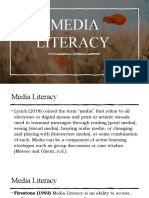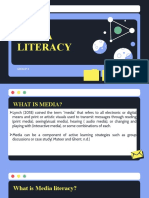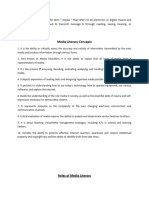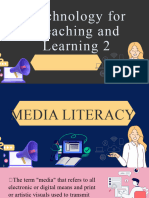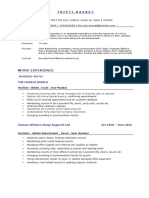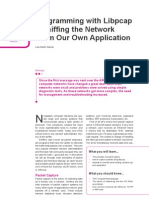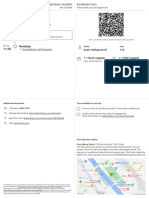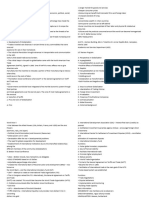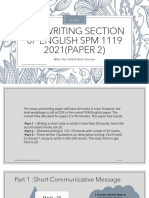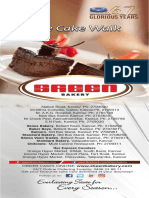Module VII- Media Literacy
Uploaded by
Dhareen LaguingModule VII- Media Literacy
Uploaded by
Dhareen LaguingModule VII
Media Literacy
• Define media Literacy
• Explain Media Information
Literacy along with various
aspects and dimensions
• Demonstrate how MIL can be
integrated in the curriculum.
Concept Exploration
Today, information comes through an interwoven system of media technologies. The
ability to read many types of media has become an essential skill in the 21st Century.
Thus, schools are greatly confronted with this challenge.
Lynch (2018) coined the term “media” that refers to all electronic or digital means and print or artistic
visuals used to transmit messages through reading (print media), seeing (visual media), hearing (audio media), or
changing and playing with (interactive media), or some combinations of each.
Media Literacy Concepts
1. It is the ability to critically assess the accuracy and validity of information transmitted by the mass media
and produce information through various forms.
2. Also known as Media Education, it is the ability to realize that all kinds of media show a representation
of reality.
3. It is the process of accessing, decoding, evaluating, analyzing and creatin g both print and electronic media
(Aufderheide, 1993).
4. It depicts experience of reading texts and designing hypertexts made possible through technology (Hobbs,
2007)
5. It pertains to understanding how to use today’s technology, how to operate equipment, use various
softwares and explore the Internet.
6. As a 21st Century approach to education, media literacy builds understanding of the role of media in
society, as well as the essential skills of inquiry and self-expression necessary for democratic citizens.
7. It represents response to the complexity of the ever-changing electronic environment and communication
channels.
8. Critical evaluation of media requires the ability to analyze and disseminate various features to others.
9. It is about teaching critical media management strategies, including ICTs in schools and learning centers.
10. It includes the ability to perform effective internet searches, awareness and respect of intellectual property
and copyright law and the ability to identify truth from fake news.
(https://www/igi.global.com/dictionary/media-literacy/18156)
Roles of Media Literacy
1. Learn to think critically
2. Become a smart consumer of products and information
3. Recognize point of view
4. Create media responsibility
5. Identify the role of media in our culture
6. Understand the author’s goal
1. Social Media Networking Sites
The term “social network” is synonymous with Facebook, although the big-picture concept applies to
most major social sites.
The purpose of social networking is pretty straightforward: that is, to provide users a platform to connect
with others. Of the various types of social media, networking sites such as Facebook, Twitter and LinkedIn
represent the bread and butter of modern marketers. After all, these sites put marketers on a level playing field
with their clients, customers and leads when it comes to, well, networking.
2. Social Media Photo and Video Sharing.
It allows users to upload photos through Facebook, Instagram, and Pinterest while videos through
YouTube.
3. Social Media News and Websites
It entails user to submit links to Web content like articles, podcasts, videos, etc. that they find interesting,
such as Digg, Reddit and Stumble Upon.
4. Microblogging and Blogging Websites
Sometimes called “presence apps”, these services let users post every short messages like blogging, and
easily keep up with what their friends are posting. Twitter is the most popular microblogging service.
5. Social Media Review Websites
It shows how social reviews can make or break a company or an organization, such as Amazon and eBay.
Media and Information literacy
(MIL)
MIL is a combination of knowledge,
attitudes, skills, and practices required
to access, analyze, evaluate, use,
produce, and communicate information
and knowledge in creative, legal and
ethical ways that respect human rights
(Moscow Declaration on Media and
Information Literacy, 2012).
https://www.dw.com/en/dw-akademie/mil-index/s-54253270
The UNESCO defines it as the set of competencies top search, critically evaluate, use and contribute
information and media content wisely; the knowledge of one’s rights online; refraining from cyberbullying;
understanding related ethical issues; and engaging with media and ICTs to promote equality, free expression,
intercultural/interreligious dialog, peace, etc. (UNESCO, 2016).
Aspects of MIL
According to Reineck and Lublinski (2015), MIL is the optimal outcome of media, information and
communication technology (ICT) education along three aspects: technical skills, critical attitudes and facts about
media and ICT. Technical skills involve ability to access and use computers, mobile and other technical devices
that offer media and information content. UNESCO’s (2011) MIL curriculum delves on “accessing information
effectively and efficiently” as an aspect put into practice.
Sevens Dimensions of MIL (Shapiro and Hughes, 1996)
1. Tool Literacy. This is the ability to understand and use practical and conceptual tools of current
information technology, including software, hardware and multimedia that are relevant to education and
the areas of work and professional life.
2. Resource Literacy. This is the ability to understand the form, format, location and access methods of
information resources.
3. Social-Structural Literacy. Knowing how information is socially situated and produced, fits into the life
of groups about the institutions and social networks.
4. Research Literacy. Ability to understand and use IT-based tools relevant to the work of researchers and
scholars that include computer software for quantitative analysis, qualitative analysis and simulation.
5. Publishing Literacy. The ability to format and publish research and ideas electronically, in textual and
multimedia forms.
6. Emerging Technology Literacy. The ability to adapt to, understand, evaluate and use emerging
innovations in information technology.
7. Critical Literacy. The ability to evaluate critically the intellectual, human and social strengths and
weaknesses, potentials and limits, benefits and costs of information technologies.
Integrating Media Literacy in the Curriculum (Lynch, 2018)
1. Teach students to evaluate media.
First, students must be taught how to evaluate media. For example, teachers need to discuss bias and
sources. By showing students that media changes depending on who produced it, who the intended
audience is, and what biases may be attributed to the source, this helps students learn to evaluate what
they are viewing.
2. Show students where to find digital resources and databases.
Teachers should also provide students with reliable media sources. This means teaching students how to
evaluate websites and digital resources for trustworthy content. For instance, there are several databases
designed for students to use for safe resources.
3. Compare/contrast various media sources.
In your discussions, compare/contrast various media sources. For example, when you cover a news story,
have students read the story from different sources. When you are discussing films or television, compare
elements.
4. Discuss how the media edits and alters.
Purposely point out examples of media altering photographs or stories. Teach students to be leery of what
they see or read at face value. For instance, when they realize the magazines have been altered, it makes
a difference in how they perceive themselves.
5. Examine the “truth” in advertisements.
Have students identify what advertisements are trying to sell and what “promises” or ideas are they using
to convince you to buy the product.
6. Have students create media.
Finally, have students create media. Depending on the grade level, you can have students create
presentations, videos, or websites. For example, students can create movie posters of movie trailers.
Transforming concepts of media literacy into pedagogical practice can be a major challenge. Media
Services program development has been inspired by three approaches to teaching media education highlighted in
Douglas Kellner & Jeff Shares article, Critical Media Literacy is Not an Option (2007).
Approaches to Teaching Media Literacy
1. Media Arts Education Approach
"students are taught to value the aesthetic qualities of media and the arts while using their creativity for
self-expression through creating art and media".
2. Media Literacy Movement Approach
"[the media literacy movement] approach attempts to expand the notion of literacy to include popular
culture and multiple forms of media (music, video, Internet, advertising, etc.) while still working within a
print literacy tradition"
3. Critical Media Literacy Approach
"[critical media literacy] focuses on ideology critique and analyzing the politics of representation of
crucial dimensions of gender, race, class, and sexuality; incorporating alternative media production; and
expanding textual analysis to include issues of social context, control, resistance, and pleasure. A critical
media literacy approach also expands literacy to include information literacy, technical literacy,
multimodal literacy, and other attempts to broaden print literacy concepts to include different tools and
modes of communicating"
Module VI Activity Sheets
Name: __________________________________ Subject: Building & Enhancing New
Literacies Across the Curriculum
Subject Facilitator: Dhareen O. Laguing, MAT
This Modules Discussion Questions
1. What is Media Literacy? Explain. (Minimum of 2 paragraphs)
____________________________________________________________________________________
____________________________________________________________________________________
____________________________________________________________________________________
____________________________________________________________________________________
____________________________________________________________________________________
____________________________________________________________________________________
____________________________________________________________________________________
____________________________________________________________________________________
____________________________________________________________________________________
____________________________________________________________________________________
____________________________________________________________________________________
____________________________________________________________________________________
____________________________________________________________________________________
____________________________________________________________________________________
____________________________________________________________________________________
____________________________________________________________________________________
____________________________________________________________________________________
____________________________________________________________________________________
2. What are the advantages and disadvantages of media?
____________________________________________________________________________________
____________________________________________________________________________________
____________________________________________________________________________________
____________________________________________________________________________________
____________________________________________________________________________________
____________________________________________________________________________________
____________________________________________________________________________________
____________________________________________________________________________________
____________________________________________________________________________________
____________________________________________________________________________________
____________________________________________________________________________________
____________________________________________________________________________________
____________________________________________________________________________________
____________________________________________________________________________________
____________________________________________________________________________________
3. How can you integrate MIL in the curriculum across disciplines? Cite Examples
____________________________________________________________________________________
____________________________________________________________________________________
____________________________________________________________________________________
____________________________________________________________________________________
____________________________________________________________________________________
____________________________________________________________________________________
____________________________________________________________________________________
____________________________________________________________________________________
____________________________________________________________________________________
____________________________________________________________________________________
____________________________________________________________________________________
____________________________________________________________________________________
You might also like
- Media Literacy: EED 101 Building and Enhancing New Literacies Across The CurriculumNo ratings yetMedia Literacy: EED 101 Building and Enhancing New Literacies Across The Curriculum52 pages
- Media-Literacy-Education-Presentation-in-Colorful-Illustrative-Style_20241019_231607_0000No ratings yetMedia-Literacy-Education-Presentation-in-Colorful-Illustrative-Style_20241019_231607_000048 pages
- Building and Enhancing New Literacies Across The Curriculum100% (1)Building and Enhancing New Literacies Across The Curriculum2 pages
- Module-5-Media-Literacy-Autosaved-.pptxNo ratings yetModule-5-Media-Literacy-Autosaved-.pptx14 pages
- Q1 W2 Media Literacy Information Literacy and Technology Literacy100% (1)Q1 W2 Media Literacy Information Literacy and Technology Literacy5 pages
- Module 7 Media Literacy (ENCANTO)_20250111_211752_0000No ratings yetModule 7 Media Literacy (ENCANTO)_20250111_211752_000092 pages
- Introduction To Media and Information LiteracyNo ratings yetIntroduction To Media and Information Literacy30 pages
- Q1 W2 Media Literacy Information Literacy and Technology Literacy100% (1)Q1 W2 Media Literacy Information Literacy and Technology Literacy5 pages
- Chapter 1 Intro. To Media and Info. Literacy 1.2100% (1)Chapter 1 Intro. To Media and Info. Literacy 1.25 pages
- Beige Yellow Aesthetic Thesis Defense Presentation - 20231001 - 072956 - 0000No ratings yetBeige Yellow Aesthetic Thesis Defense Presentation - 20231001 - 072956 - 000034 pages
- The Role of Social Media in Society: A Simple Guide to Big IdeasFrom EverandThe Role of Social Media in Society: A Simple Guide to Big IdeasNo ratings yet
- Module III - New Literacies, Functional Literacy and Multi LiteracyNo ratings yetModule III - New Literacies, Functional Literacy and Multi Literacy6 pages
- ED 108 (Assessment of Learning 1 Syllabus)No ratings yetED 108 (Assessment of Learning 1 Syllabus)13 pages
- Topic 5 Development of Varied Assessment ToolsNo ratings yetTopic 5 Development of Varied Assessment Tools35 pages
- Psychological Pricing in Online Food Retail (2021)No ratings yetPsychological Pricing in Online Food Retail (2021)15 pages
- Amended Operation Candy Crush Complaint (12/20/2018)No ratings yetAmended Operation Candy Crush Complaint (12/20/2018)23 pages
- Precipitation Behavior in ZR 2.5 NB AlloysNo ratings yetPrecipitation Behavior in ZR 2.5 NB Alloys9 pages
- Tripping Jazz: Leni Stern'S Melodic ExcursionsNo ratings yetTripping Jazz: Leni Stern'S Melodic Excursions7 pages
- Verses of The Senior Monks (Bhikkhu Sujato & Jessica Walton)No ratings yetVerses of The Senior Monks (Bhikkhu Sujato & Jessica Walton)267 pages
- Ch.11 Michael Houseman Immersive Hugging as a Ritual ActNo ratings yetCh.11 Michael Houseman Immersive Hugging as a Ritual Act21 pages
- Clinical Training at TANUVAS by M. Murshidul AhsanNo ratings yetClinical Training at TANUVAS by M. Murshidul Ahsan3 pages
- THE WRITING SECTION 0F English SPM PART 1No ratings yetTHE WRITING SECTION 0F English SPM PART 129 pages
- 31 What Is A GOCC Without A Charter Feliciano v. COA. COANo ratings yet31 What Is A GOCC Without A Charter Feliciano v. COA. COA9 pages
- Evidence I (LLB-680) : Week 13: Relevancy of The Opinions of Third PersonsNo ratings yetEvidence I (LLB-680) : Week 13: Relevancy of The Opinions of Third Persons2 pages
- Instant Download Turkey s Mission Impossible War and Peace with the Kurds Kurdish Societies Politics and International Relations 4th Edition Çandar PDF All Chapters100% (7)Instant Download Turkey s Mission Impossible War and Peace with the Kurds Kurdish Societies Politics and International Relations 4th Edition Çandar PDF All Chapters55 pages























